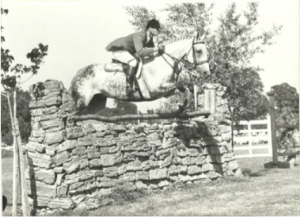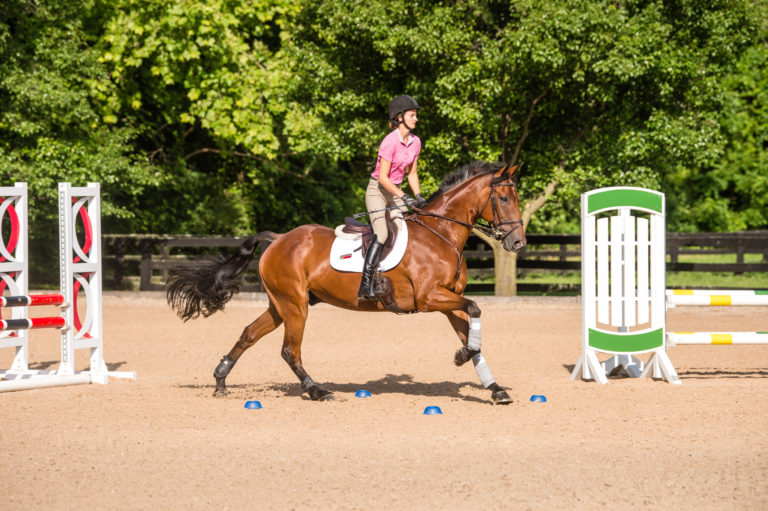Your lower leg position will determine to a great extent your success or failure in the two jumping phases of modern eventing, show jumping and cross-country. In my recent column “A Leg To Stand On,” I described in detail the correct position of your lower leg for show jumping. However, due to space constraints, I was unable to give you exercises to strengthen and improve your lower leg position. In this Internet supplement, I will suggest several of those exercises.
1) With your stirrups, go at the posting trot, then cease posting at the top of the “up” phase of the motion and stay poised above your horse’s withers, taking the shock of your horse’s movement in your knees and ankles. You can do this exercise at all three gaits. Maintain a soft, consistent connection with your horse’s mouth by carrying your hands just above the withers with supple elbows. Do not straighten your knees or rest your weight against your horse’s neck. (While this is more comfortable for you, an incorrect position avoids the difficulty of this exercise and, even worse, drives your weight straight down into your horse’s withers with every step or stride.)
2) Posting the trot without stirrups is an excellent exercise to strengthen your lower leg position. It has additional advantages: it’s an exercise that you can do without any special facilities, and is something you should do before attempting my next exercise. Before you start, place your knees a little high in the saddle so that you have sufficient leverage to produce your posting motion. This exercise is surprisingly difficult to do, and you will find your knees slip down after a few minutes. When this happens, practice lifting your knee up in the saddle. This is the same motion you need to make when attempting to regain your stirrup after it becomes dislodged, so you are practicing something that will make you safer and more effective, as well as fitter. While posting, remember to relax your elbows as you rise, so that your hands do not move up and down with your posting motion.
3) For this third exercise, you need three things: a neck-strap, a jumping chute and a suitable horse. By “suitable,” I mean you need a horse that will trot and canter quietly over gymnastics. The neck-strap is easy; use a spare stirrup leather, adjusted one-third of the way up your horse’s neck. The jumping chute is a little more complicated. Using an indoor arena, or an enclosed outdoor arena, place a gymnastic line of jumps down one long side. Start with a placing pole 9 feet in front of a small vertical, then build a second vertical 18 feet away, followed 19 feet later by an oxer. Put wings on the inside standard of each jump. (The wall serves as the wing on the other side of the jump.)
Once you have measured the distances and made sure the jumps are perpendicular to the wall, remove all the rails except two poles on the ground 9 feet apart on the end of the gymnastic where you will build the first vertical, leaving all three wings in place.
When you first start to build the gymnastic, keep your reins and stirrups. Rehearse your horse through the gymnastic as you gradually add one more jump. If your horse shows any signs of over-exuberance, teach him that you expect him to trot quietly into the placing rail and the following gymnastic, then canter away from the gymnastic and pull up to a halt in the corner at the end of the line of jumps. I have my students perform a turn on the forehand or a turn on the haunches, depending on the level of training of the horse, and walk out of the corner before attempting the gymnastic again. This helps prevent your horse from bolting through the corner while he attempts to launch you into the rafters.
Once your horse is settled, take a short break while you tie a knot in your reins. This is just to shorten the reins, and place a knot in your reins you can easily locate and pick up again after you have jumped the gymnastic without your reins.

I want you to trot into the gymnastic, keeping your stirrups (for now) and holding your reins, but this time, drop the reins on the neck just before the placing pole and cross your arms in front of you. Obviously, regain your reins after the gymnastic and pull up in the corner, as you taught your horse to do earlier. You can do this exercise with your arms crossed in front of you, crossed behind you or extended at shoulder height.
Take another break while you make sure your neck strap is adjusted correctly one-third of the way up your horse’s neck. (If it is too loose, you will find yourself pulling with your hands in your lap, which is ineffective.) This time, I want you to cross your stirrups in front of the saddle, and hold the neck strap while you jump the gymnastic. Once you drop your stirrups, make sure that you keep your knees up against the knee roll of your saddle. If you allow your knees to slip down in the saddle, you will not be able to follow the jumping motion correctly. (You may need to remove the stirrups altogether if they cause too much interference with your thigh.)
Practice the gymnastic several times using the neck strap, to make sure that your position is secure. Once you are confident in the strength and security of your lower leg, you can do the same arm exercises as before, but this time do them without your stirrups. Continue to pull up to a walk at the end of the line, for safety reasons.
Unless you are a very experienced rider, you should not expect to complete all of these exercises in your first session. If you are just coming back to jumping after a break, it will take you several lessons, plus some serious gym-time, to develop the strength and fitness required. However, the added stability and security of your jumping position will be worth the effort.










